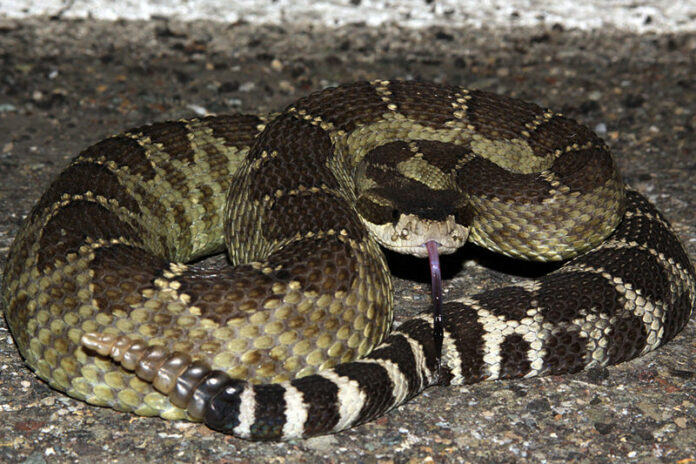With the warm weather of summer, people like to get out and about in California famous natural environment, but in doing so we enter the territory of one misunderstood, but still dangerous, native species — the rattlesnake.
The first thing to know about rattlesnakes in Sonoma County, is there is really only one, the Northern Pacific rattlesnake. According to californiaherps.com, adults are normally 15-36 inches long, though they can be as long as 48 inches. They are described as a heavy-bodied pit viper, with a thin neck, a large triangular head and a rattle on the end of the tail consisting of loose interlocking hollow segments, pupils are elliptical, scales are keeled. The ground color is variable, matching the environment — olive-green, gray, brown, golden, reddish brown, yellowish, or tan.
Dark brown or black blotched markings, usually with dark edges and light borders, mark the back, with corresponding blotches on the sides. Dorsal blotches mark the front 2/3 of the body, change to dark bars on the body and dark and light rings on the tail, which are well defined, and of uniform width. The underside is pale, sometimes weakly mottled. Usually there is a light stripe extending diagonally from behind the eye to the corner of the mouth. Young are born with a bright yellow tail with no rattle — just a single button which does not make a sound.”
According to the California Poison Control System, more than 300 cases of rattlesnake bites are reported annually in California, with additional cases also managed by physicians and hospitals.
According to the United States Department of Agriculture (USDA), most rattlesnake bites occur between the months of April and October. While many people are terrified by the prospect of coming across a rattlesnake, the truth is the snake’s first choice will always be to avoid humans, and the best way to prevent an encounter is to help the snakes do just that.
About 25 percent of the bites are “dry,” meaning no venom was injected, but the bites still require medical treatment. Depending on weather and threatening conditions such wildfires, rattlesnakes may roam at any time of the day or night. If walking at night, be sure to use a flashlight.
The USDA recommends these precautions:
• Wear appropriate over-the-ankle hiking boots, thick socks, and loose-fitting long pants. Never go barefoot or wear sandals when walking through wild areas.
• When hiking, stick to well-used trails.
• Avoid tall grass, weeds and heavy underbrush.
• Look at your feet to watch where you step and do not put your foot in or near a crevice where you cannot see.
• Do not step or put your hands where you cannot see, and avoid wandering around in the dark.
• If a fallen tree or large rock is in your path, step up on to it instead of over it, as there might be a snake on the other side.
• Be especially careful when climbing rocks or gathering firewood.
• Check out stumps or logs before sitting down and shake out sleeping bags before use.
• Do not turn over rocks or logs. If you must move a rock or log, use gloves and roll it toward you, giving anything beneath it the opportunity to escape in the opposite direction.
• Never grab “sticks” or “branches” while swimming in lakes and rivers. Rattlesnakes can swim.
• Avoid approaching any snake you cannot positively identify.
• If you hear the warning rattle, move away from the area and do not make sudden or threatening movements in the direction of the snake.
• Remember rattlesnakes do not always rattle before they strike.
• Do not handle a freshly killed snake—it can still inject venom.
If you live in snake country, your best defense against rattlesnakes can actually be another snake. California Kingsnakes (easily identifiable by their dramatic black and white ringed coloring) love nothing more than making a meal of a rattlesnake. A healthy kingsnake population will keep rattlers in check and often drive them out of an area all together.
Similarly, the rattler-lookalike gopher snakes are not going to eat a rattler, but they are extremely territorial and will generally not tolerate rattlers in their dens. The easiest way to tell a gopher from a rattler is by checking the tail, but their heads are also quite different: gophers have an oblong head the same width as their bodies, while rattlers have a large, triangular-shaped head. Gophers will sometimes mimic rattlesnake behavior when threatened so it’s important to determine which species you are faced with.
Despite their reputation, and their ability to inflict harm on unsuspecting people, rattlesnakes serve a vital role in the ecosystem and are the primary means of rodent control in the United States, according to the USDA. With a little consideration, we can live in harmony with these unique animals.
If you see a rattlesnake in the wild, leave it be and it will do the same. If you see a rattlesnake on your property and don’t want it around remember that you don’t have to kill it. You can call Al Wolf at Sonoma County Reptile Rescue 24 hours a day, at 321-0504, and he will remove the snake free of charge.
64.1
F
Healdsburg
May 25, 2025










